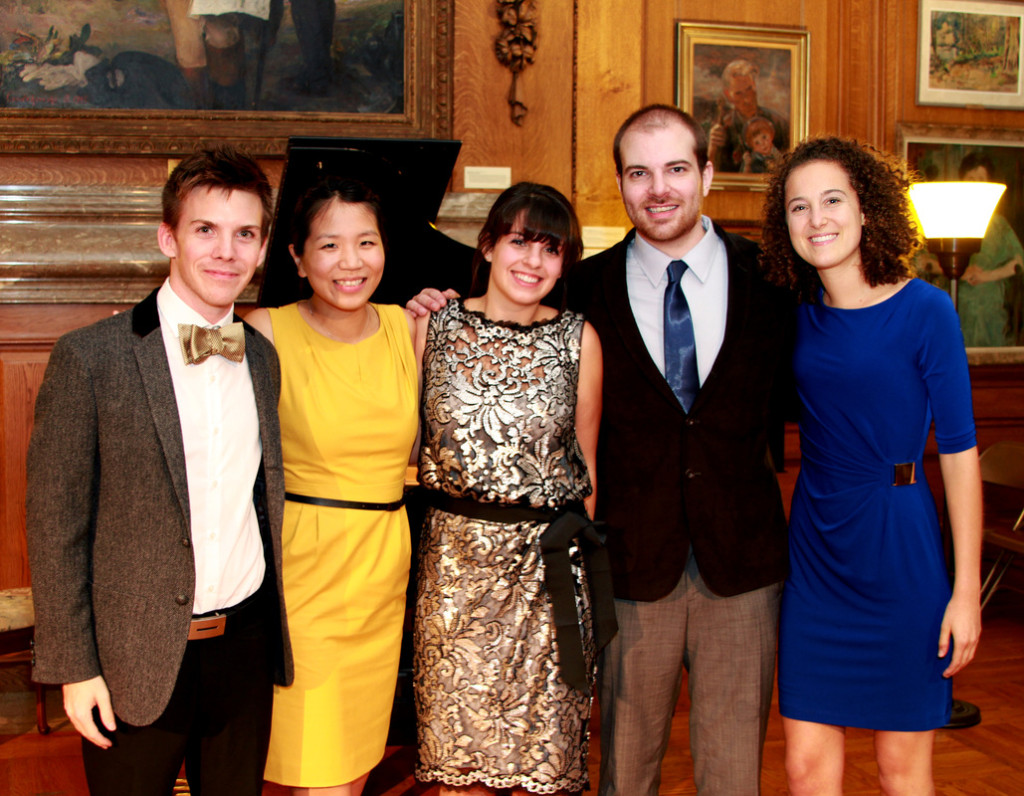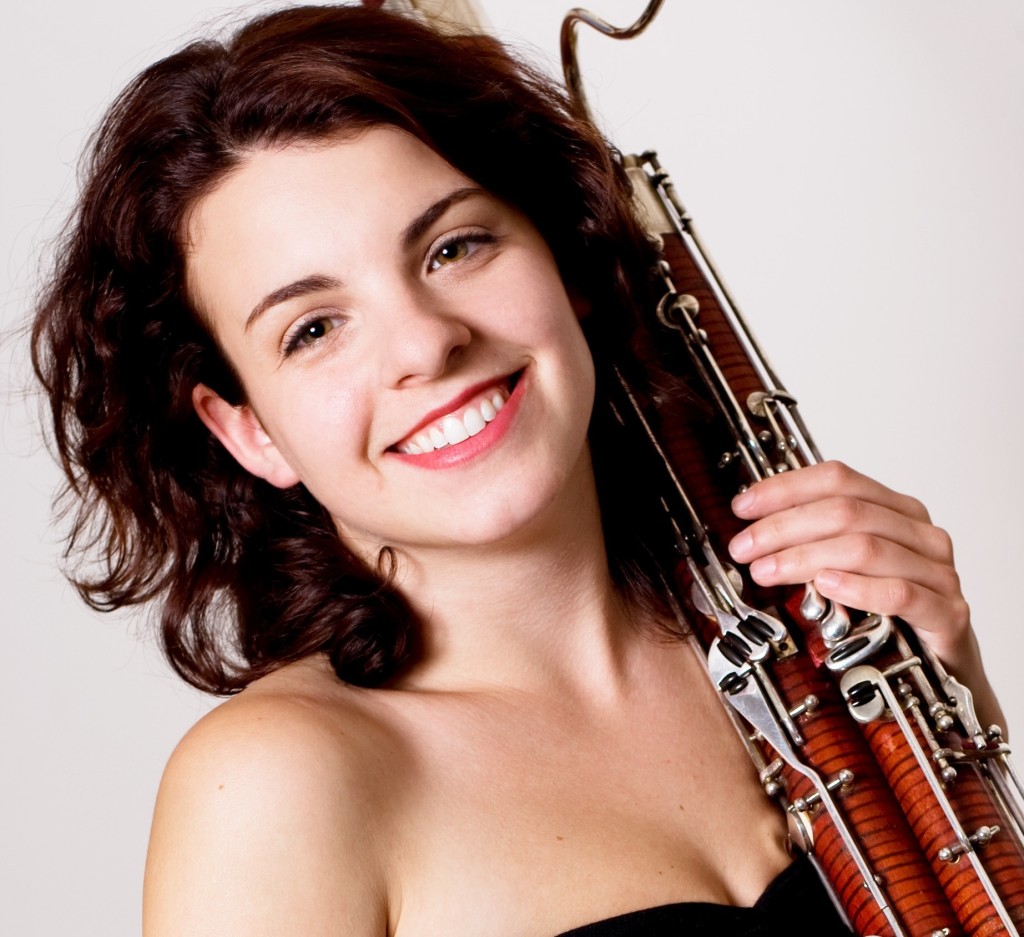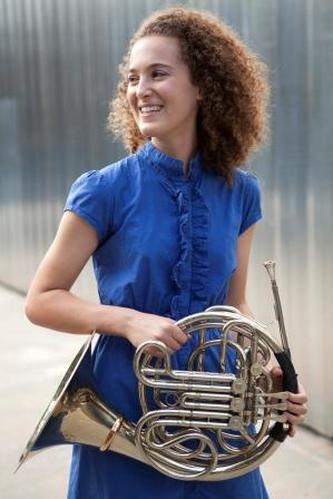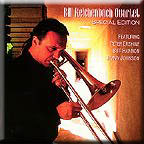In the words of Windsync oboist Erin Tsai, “We are approachable and accessible to seasoned concert goers AND to those who have never heard classical music”. In a wind chamber music environment dominated by brass touring groups, Windsync has drawn from the best of those traditions, blended in their own unique and yet cohesive musical personalities and added dash of inspiration from the Imani Winds to fashion a compelling and mesmerizing chamber music ensemble. Breaking boundaries and blazing trails seems matter of course for the group, as they incorporate blocking, memorization, costumes and unusual spaces into their performances. “Five!” tm, is davidbrubeck.com’s celebration of chamber music quintets, and we are scintillated to sail our maiden voyage with the delightful and generous members of Windsync! 
Garrett Hudson-Flute
1. How did you guys meet?
I think we each have a unique and fascinating story to tell when it comes to how we all met and came to join WindSync. As we all know, the music world can be a very small place and some of us crossed paths years before the WindSync dream ever emerged. For instance, Erin and I met at an international music competition in Canada… where she beat me. Tracy crossed paths with Anni in Italy at a time when we were looking to fill the horn position. Anni and Jack both pursued their Bachelors degrees together at USC. It would seem that there is often just one or two degrees of separation in the classical music community.
2. What do you most enjoy (or learn) when listening to string quartets or brass quintets as opposed to wind quintets? What do you miss?
What I most enjoy when hearing string and brass chamber ensembles is the uniformity of sound that those combinations of instruments are able to create. Not only are their instruments made of the same material, but the way they produce sound is also identical; a bow across a string or the buzzing of the lips through a mouthpiece. The flip side of this is that I love the unique and individual qualities that one finds in the Wind Quintet. Each of our instruments are made from different materials; silver, brass, various woods. Equally interesting is the fact that we produce sound in different ways. Having 5 unique instruments provides us with an endless palate of colors and textures to choose from when we’re creating music together.
3. How much do you keep the audience in mind when selecting a program?
Always. I don’t think we’d have much of an audience if we didn’t consider what our programs can offer. One of the beautiful things about WindSync is our desire – our need – to innovate and try new things. We find that our audiences appreciate being a part of that exploratory process with us and, truth be told, we have many years behind us of trial and error that have led to the exciting and meaningful programs that we try to sculpt for our audiences today.
 Erin Tsai-Oboe
Erin Tsai-Oboe
1. How do you approach playing melody as opposed to accompaniment? Is it hard not to draw attention to your part as an oboist?
When I’m playing the melodies, I think of myself as an principal oboe player in an orchestra, but when I’m playing an accompaniment figure, I think of myself as a second player to whomever has the melody and try to blend to his or her instrument’s tone as much as possible. There are some hunky low notes on the oboe that are just really hard to hide; luckily my colleagues understand and know to help-by either playing the rest of the chord fuller or when arranging a piece for the group avoiding low ‘Bb’ on the oboe in a pp setting.
2. Which Wind Quintets have inspired you and how? Which Wind Quintet has come closest to the success of say The Canadian Brass?
The Imani Winds have always been an inspiration. We love the energy, dynamic, and professionalism that they bring to the stage; meanwhile, they are also humble and personable. Although not a wind quintet, eight blackbird has been a great inspiration to the group as well. We also highly respect many string quartets and admire some of the best repertoire that has ever written for them.
3. How important is visual communication when you perform?
Visual communication, such as eye contact, facial expression, and body movement, is extremely important for us in a performance, not only among ourselves, but also between us and the audience members. This is one of the reasons that we chose to get rid of the music stands completely when we perform-to reduce the distance between everyone.
Tracy Jacobson-Bassoon
 1. How important is the choreography? How does it help the music? How does it get in the way?
1. How important is the choreography? How does it help the music? How does it get in the way?
Some elements of choreography are completely essential for us to play. We’ve become accustomed to using our bodies to enhance our playing abilities and to play together. We also find that it often helps the audience to focus their listening at any given point in a piece.
2. A new law decrees that the instrumentation of the woodwind quintet must change! Which instrument would you remove, and which would you replace it with? Why?
All of the instruments in the wind quintet create essential sounds and fill musical roles that really can’t be replaced. I would add a bandoneon, which is also a wind instrument and creates a fantastic blend and sustain in the group, but unfortunately, I don’t think there’s an instrument we can do without!
3. You have placed an emphasis on solo bassoon, how does that help you accompany others? Is it frustrating to have the melody less frequently?
As bassoonists, we’re accustomed to infrequently playing the melody and learn the joys of playing a supportive voice. In an orchestral context, my greatest frustration was with not being heard-rather than a lack of the lead lines. Fortunately for me, in a quintet, the bassoon is always present so I never need to worry about my part being inconsequential. I do enjoy my moments in the spotlight, but am just as excited to lay down a solid bass line.
 Jack Marquardt -Clarinet
Jack Marquardt -Clarinet
1. How do you approach blending differently with each of the other instruments?
The most important thing to keep in mind when blending with other instruments is to know your own instrument’s tendencies in terms of pitch issues and sound distortions that may arise at different dynamic levels so you can best compensate to match your colleagues.
Flute – Generally the flute and clarinet are written in octaves when playing together, so it is important to create a large body of sound that resonates well and is not forced. The flute tends to play at the higher end of the pitch spectrum when it is at the top of its register, so it can be very helpful to ride a little higher with your pitch so you can make the flautist’s life a little easier.
Oboe – Composers often love writing for Clarinet and Oboe in unison, with the most famous example being the opening of Schubert’s Unfinished Symphony. This can be a very rewarding blend to create; capable of so many colors beyond what our individual instruments can create by themselves. It is very important to have a dialogue about who is leading the sound and who has a more subservient role, so that neither is competing with each other to dominate the sound.
Horn – The Clarinet and Horn are capable of creating the largest bodies of sound and often have to work together to simulate a large brass section.
Bassoon – Often the Clarinet and Bassoon are written in octaves. It’s important in this situation for the Clarinet to play into the Bassoon’s sound and let that instrument dominate the collective sound.
2. How important is chemistry in chamber music-personal and musical?
Chemistry is one of the most important factors contributing to the success of a chamber ensemble. We try to make sure that we communicate to our audiences our love for each other and how much we enjoy making music with each other. It adds that extra layer to a performance that really makes the music come alive to us.
3. How do you select, rehearse and stage a new piece?
We have five very different musical aesthetics within the group, so choosing repertoire that all of us will enjoy can be challenging at first, but even if one or two members do not always care for a particular piece, we can always come to a unanimous consensus within the group about which pieces will be best for the group and showcase our strengths the most. We always begin learning new pieces with the music first; we try not to memorize as we learn the piece.
Anni Hochhalter-French Horn
1. If you could add a sixth regular instrument to the group, and literature was not a consideration, which instrument would it be and why?
I would include a harp. This instrument would add beautiful colors and textures but also provide a great source of rhythm.
2. How different is the student chamber music experience to that of a touring professional? What experiences most prepared you?
Honestly, the life of a student practicing chamber music is the exact opposite from the life of a touring professional with one exception – performance time. Your tour environment is unpredictable, your sense of routine completely vanishes, and you spend more time with your fellow musicians without your instruments in your hands than with them. This is a stark contrast to the hours spent in a comfortable practice room with your group, the consistency of daily habits, sleeping in your own bed every night, and preparing for a concert held in familiar location. However, the skills honed in those hours of practice and rehearsal as a student will be the greatest tools for success.
The experiences that most prepared me for touring as a musician were those that took me out of my familiar surroundings. During my undergraduate I had the opportunity of performing all over Los Angeles with a horn quartet and even went on a tour to New Orleans. I have relied upon these fundamental experiences ever since. As a side note for touring, remember your routines and habits that keep you healthy and happy as a person and musician and cling to them! That way you can be as flexible as possible in other ways for the group.
I had the opportunity of performing all over Los Angeles with a horn quartet and even went on a tour to New Orleans. I have relied upon these fundamental experiences ever since. As a side note for touring, remember your routines and habits that keep you healthy and happy as a person and musician and cling to them! That way you can be as flexible as possible in other ways for the group.
3. Which is more important to your impressive ensemble playing: familiarity with the composition, listening or familiarity with each others’ playing?
At this point, it is most important that we are familiar with the composition. It has been a real gift to play with the same musicians for an extended period of time and to work so closely with them year after year. It seems that we can almost predict each others playing and even instinctively accommodate to one another, and that is a huge part of the experience for the audience.
c. 2014 David William Brubeck All Rights Reserved. davidbrubeck.com
Interested in more “FIVE” tm interviews?
Canadian Brass 2014, Windsync 2014, Boston Brass 2015, Mnozil Brass 2015, Spanish Brass 2014, Dallas Brass 2014, Seraph 2014, Atlantic Brass Quintet 2015, Mirari Brass 2015, Axiom Brass 2015, Scott Hartmann of the Empire Brass 2015, Jeffrey Curnow of the Empire Brass 2015, Ron Barron and Ken Amis of the Empire Brass, Meridian Arts Ensemble 2015, Berlin Philharmonic Woodwind Quintet 2015, American Brass Quintet 2015

